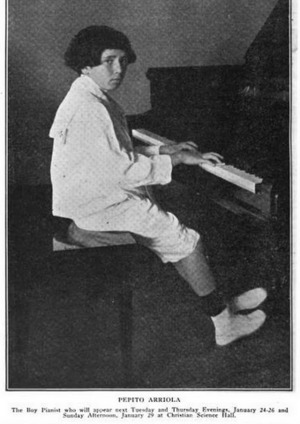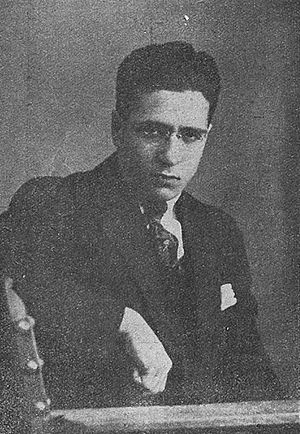Pepito Arriola facts for kids
Pepito Arriola was an amazing Spanish musician. He was born on December 14, 1896, and passed away on October 24, 1954. Pepito was a true child prodigy, meaning he had incredible talent from a very young age. He started as a brilliant pianist and later became a master violinist.
Contents
Pepito's Early Life
Pepito was born in a city called Ferrol, in Spain. His mother was Josefa Rodríguez Carballeira. When his mother moved to Madrid, his aunt, Aurora, looked after him. She was the one who first taught him how to play the piano.
How Pepito's Talent Was Discovered
Pepito's amazing musical talent was found when he was only two and a half years old! His mother often played a song on their home piano. One day, she heard the song being played perfectly. She was surprised to find her young son playing the piece himself.
Pepito had no lessons, but he started his career as a pianist right away. Sometimes he played songs he had heard. Other times, he created his own original music. After his mother saw his incredible skills, she took him to Madrid. That's where his career as a concert pianist truly began.
Amazing Performances
Pepito Arriola gave his first public performance on December 4, 1899. He was not even three years old yet! The audience included important music critics and musicians. Just after his third birthday, on December 26, he played his second concert. This special performance was at the Royal Palace of Madrid for the King and Queen. He played six of his own songs!
Later, Pepito also became a great violinist. He impressed people all over Europe with his concerts. He played in the German city of Leipzig and in the Russian capital of St. Petersburg. In 1911, Pepito Arriola even performed at the Elitch Theatre in Denver, Colorado. People there were excited to hear the famous young pianist.
How Pepito Composed Music
When Pepito was three, he couldn't read music or even regular words. So, his way of composing was very unusual! He would sometimes use a blank piece of paper. He would draw a symbol at the top to show what kind of piece it was, like a sonata or a waltz.
Then, he would draw random lines and notes on the paper. After that, he would put the paper in front of him and say, "I will play that." Then he would start to improvise, or make up the music on the spot, and it sounded amazing! His music was described as having "astonishing expression." It could be sad and serious or happy and cheerful.
Pepito's Musical Works
Here are some of the musical pieces Pepito Arriola created:
- Aurora habanera 1898
- Impresiones nocturnas 1916
- Hommage à Manuel de Falla/Homenaje a Falla 1942
After he passed away, 12 more musical scores were found. He wrote these in Barcelona after he returned to Spain in 1946:
- Divertimento concertante 1946
- Tres textos cervantinos voice and orchestra, 1946
- Aqui lloró Don Quixote, 1947
- Tres textos cervantinos for 2 pianos, 1947
- Concerto para trompa horn concert, 1948
- Sehilcht Weise1948
- Song 1948
- Don Quixote in DM 1949
- Seis poesías de Antonio Machado Baritone and orchestra
- Pequena serenata para cello y piano 1951
- Concertino piano e orquestra 1953
- Impresiones Argentinas
See also
 In Spanish: Pepito Arriola para niños
In Spanish: Pepito Arriola para niños



